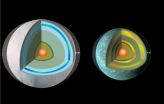(Press-News.org) Australian researchers reveal that sudden, acute episodes of low back pain are not linked to weather conditions such as temperature, humidity, air pressure, wind direction and precipitation. Findings published in Arthritis Care & Research, a journal of the American College of Rheumatology (ACR), indicate that the risk of low back pain slightly increases with higher wind speed or wind gusts, but was not clinically significant.
According to the World Health Organization (WHO) nearly everyone experiences low back pain at some point in their life, making it the most prevalent musculoskeletal condition and affecting up to 33% of the world population at any given time. Those with musculoskeletal (bone, muscle, ligament, tendon, and nerve) pain report that their symptoms are influenced by the weather. Previous studies have shown that cold or humid weather, and changes in the weather increase symptoms in patients with chronic pain conditions.
"Many patients believe that weather impacts their pain symptoms," explains Dr. Daniel Steffens with the George Institute for Global Health at the University of Sydney, Australia. "However, there are few robust studies investigating weather and pain, specifically research that does not rely on patient recall of the weather."
For the present case-crossover study 993 patients seen at primary care clinics in Sydney were recruited between October 2011 and November 2012. Weather data from the Australian Bureau of Meteorology were sourced for the duration of the study period. Researchers compared the weather at the time patients first noticed back pain (case window) with weather conditions one week and one month before the onset of pain (control windows).
Results showed no association between back pain and temperature, humidity, air pressure, wind direction or precipitation. However, higher wind speed and wind gusts did slightly increase the chances of lower back pain, but the amount of increase was not clinically important.
"Our findings refute previously held beliefs that certain common weather conditions increase risk of lower back pain," concludes Dr. Steffens. "Further investigation of the influence of weather parameters on symptoms associated with specific diseases such as fibromyalgia, rheumatoid arthritis, and osteoarthritis are needed."
INFORMATION:
This study is published in Arthritis Care & Research. Media wishing to receive a PDF of this article may contact sciencenewsroom@wiley.com.
Full citation: "Weather Does Not Affect Back Pain: Results from a Case-Crossover Study." Daniel Steffens, Chris G. Maher, Qiang Li, MBiostat, Manuela L. Ferreira, Leani S.M. Pereira, Bart W. Koes and Jane Latimer. Arthritis Care and Research; Published Online: July 10, 2014 (DOI: 10.1002/acr.22378).
URL Upon Publication: http://doi.wiley.com/10.1002/acr.22378
Author Contact: To arrange an interview with Dr.Steffens, please contact Ellie Martel with The George Institute for Global Health at emartel@georgeinstitute.org.au.
About the Journal
Arthritis Care & Research is an official journal of the American College of Rheumatology (ACR), and the Association of Rheumatology Health Professionals (ARHP), a division of the College. Arthritis Care & Research is a peer-reviewed journal that publishes both original research and review articles that promote excellence in the clinical practice of rheumatology. Relevant to the care of individuals with arthritis and related disorders, major topics are evidence-based practice studies, clinical problems, practice guidelines, health care economics, health care policy, educational, social, and public health issues, and future trends in rheumatology practice. The journal is published by Wiley on behalf of the ACR. For more information, please visit the journal home page at http://wileyonlinelibrary.com/journal/acr.
About Wiley
Wiley is a global provider of content-enabled solutions that improve outcomes in research, education, and professional practice. Our core businesses produce scientific, technical, medical, and scholarly journals, reference works, books, database services, and advertising; professional books, subscription products, certification and training services and online applications; and education content and services including integrated online teaching and learning resources for undergraduate and graduate students and lifelong learners.
Founded in 1807, John Wiley & Sons, Inc. (NYSE: JWa, JWb), has been a valued source of information and understanding for more than 200 years, helping people around the world meet their needs and fulfill their aspirations. Wiley and its acquired companies have published the works of more than 450 Nobel laureates in all categories: Literature, Economics, Physiology or Medicine, Physics, Chemistry, and Peace. Wiley's global headquarters are located in Hoboken, New Jersey, with operations in the U.S., Europe, Asia, Canada, and Australia. The Company's website can be accessed at http://www.wiley.com.
Low back pain? Don't blame the weather
2014-07-10
ELSE PRESS RELEASES FROM THIS DATE:
New class of anti-arthritis drugs effectively treats multiple inflammatory diseases
2014-07-10
Philadelphia, PA, July 10, 2014 – Inflammatory diseases can occur simultaneously in distinct sites in the same patient, complicating treatment because a medication effective for one disorder may exacerbate the other. One such example is the anti-arthritic medication dexamethasone, which alleviates joint disease but can worsen periodontal bone disease. A study in the August issue of The American Journal of Pathology highlights the effects of a new class of anti-arthritic drugs, specifically DTrp8-ɣMSH (DTrp), that acts via the melanocortin (MC) system to reduce both ...
Urban Aboriginal people face unique health challenges
2014-07-10
TORONTO, July 10, 2014 – For the first time, researchers have access to detailed information about how an urban Aboriginal population in Canada uses health care. A new study, called Our Health Counts, uses this health database to clearly demonstrate the unique challenges faced by urban Aboriginal people in Canada – according to researchers at St. Michael's Hospital.
The findings, published today in BMJ Open, illustrate striking disparities between urban First Nations individuals and the general population.
Researchers interviewed 554 First Nations adults in Hamilton, ...
The millennial tofu surprise
2014-07-10
While Tofu is considered a healthy source of protein, that's not why the Millennials are eating it, according to a new study to be presented at Tops Club Inc.'s annual International Recognition Days convention July 10th in Milwaukee.
Tofu's new champion recruits are 20-something women who want dishes that are quick, easy to cook and that can help keep them trim. "They basically seem to care less about any health benefits of Tofu," said lead Cornell researcher Brian Wansink, "They eat it to look good and because it's quick to cook and it's filling."
The study of 502 ...
Research reveals how key controller protein is switched on
2014-07-10
New research has uncovered how a complex protein pivotal in the development of cancer, viral infection and autoimmune diseases is activated. The discovery answers a key question about one of the most widely-researched proteins in human biology, which has been the subject of tens of thousands of research papers and millions of pounds in research funding.
Jiazhen Zhang, a research student in Professor Sir Philip Cohen's laboratory at the University of Dundee, uncovered how the protein complex, called NF-κB, is activated. The results are published today in the Biochemical ...
Mouse study: Natural birth may strengthen the immune system
2014-07-10
A number of studies suggest that children delivered by Caesarean section have a different intestinal flora than children delivered by natural birth. But it is still unknown why this is the case and what it means for the immune system. Researchers from the Faculty of Health and Medical Sciences therefore decided to scrutinise the impact of birth on the development of the immune system in a study of newborn mouse pups.
The study shows that pups delivered by Caesarean section had developed a lower number of cells that strengthen the immune system, says Camilla Hartmann ...
Vasectomy may increase risk of aggressive prostate cancer
2014-07-09
Boston, MA -- Vasectomy was associated with a small increased risk of prostate cancer, and a stronger risk for advanced or lethal prostate cancer according to a new study from Harvard School of Public Health (HSPH). The researchers found that the association remained even among men who received regular PSA screening, suggesting the increased risk of lethal cancer cannot be explained by diagnostic bias. It is the largest and most comprehensive study to date to look at the link between vasectomy and prostate cancer.
The study appears online July 7, 2014 in Journal of Clinical ...
Bacteria found in bladders of healthy women differ from those in women with incontinence
2014-07-09
Bacteria found in the bladders of healthy women differ from bacteria in women with a common form of incontinence, according to researchers from Loyola University Chicago Stritch School of Medicine.
These findings, published July 9, 2014, in the American Society for Microbiology's online journal mBio, suggest that bacterial communities may play a role in female urinary health.
"Urgency urinary incontinence (UUI) is a common, yet poorly understood, condition with symptoms similar to urinary tract infections," said Alan Wolfe, PhD, co-investigator and professor of Microbiology ...
NASA finds friction from tides could help distant earths survive, and thrive
2014-07-09
As anybody who has started a campfire by rubbing sticks knows, friction generates heat. Now, computer modeling by NASA scientists shows that friction could be the key to survival for some distant Earth-sized planets traveling in dangerous orbits.
The findings are consistent with observations that Earth-sized planets appear to be very common in other star systems. Although heat can be a destructive force for some planets, the right amount of friction, and therefore heat, can be helpful and perhaps create conditions for habitability.
"We found some unexpected good news ...
NASA MESSENGER and STEREO measurements open new window into high-energy processes on the sun
2014-07-09
Understanding the sun from afar isn't easy. How do you figure out what powers solar flares – the intense bursts of radiation coming from the release of magnetic energy associated with sunspots – when you must rely on observing only the light and particles that make their way to near-Earth's orbit?
One answer: you get closer. NASA's MESSENGER spacecraft -- which orbits Mercury, and so is as close as 28 million miles from the sun versus Earth's 93 million miles -- is near enough to the sun to detect solar neutrons that are created in solar flares. The average lifetime for ...
New recreational travel model to help states stop firewood assisted insect travel
2014-07-09
RESEARCH TRIANGLE PARK, NC, July 9, 2014 – The spread of damaging invasive forest pests is only partially powered by the insects' own wings. People moving firewood for camping can hasten and widen the insects' spread and resulting forest destruction. A new U.S. Forest Service study gives state planners a tool for anticipating the most likely route of human-assisted spread they can use to enhance survey and public education efforts.
The study, "Using a Network Model to Assess Risk of Forest Pest Spread via Recreational Travel," was published July 9 in the journal PLOS ...



